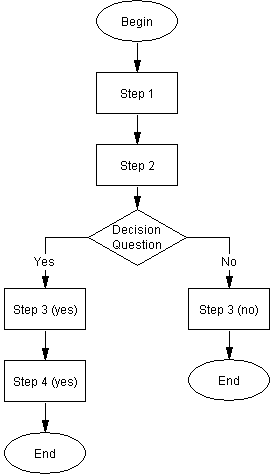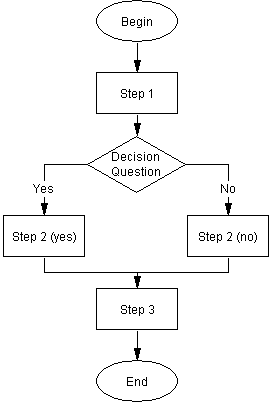Step (Process) Diagrams
Introduction and Best Uses
Process Diagram Title

diagram.
Step or process diagrams are used to illustrate the sequence of steps required to complete a particular process or procedure. If the steps are straightforward, the diagram will show just a beginning, a few steps, and an ending. As you will see, different diagram components utilize different geometrical shapes.
As Figure 1 illustrates, the diagram should have a title. The title should name the process being explained. This diagram shows an oval (labeled "Begin") followed by three rectangles (labeled "Step 1," "Step 2," and "Step 3") followed by another oval (labeled "End"). These shapes are stacked vertically, each connected to the one below by a downward-pointing arrow. Since the step diagram is used to show a sequence of steps to complete a process or procedure, the boxes should be filled in with brief verbal descriptions of the steps.
Step Diagram with Decision Point
Process Diagram Title

Sometimes within a process, you reach a point where either a yes/no decision or some other choice between two paths must be made (see Figure 2). The decision itself is designated by a diamond shape, in which you write the decision to be made. From that point, the path diverges into two paths, one coming from the "Yes" (or Choice 1) side, and one from the "No" (or Choice 2) side. Now each path will have its own "End" oval to signify that path's completion point.
Step Diagram with Decision Point Whose Paths Rejoin
Process Diagram Title

which rejoin.
Another variation is when the paths diverge for one or more steps, but then rejoin to end in steps common to both paths (see Figure 3).
Step Diagram Guidelines
The following guidelines represent best practices for creating process or step diagrams:
- Give your diagram a title that clearly identifies the process being described. The title should appear just above the whole diagram.
- Don't skip steps, but…
- Keep the description of each step brief and concise.
- Always begin with an oval labeled "Begin" or "Start."
- Always end with an oval labeled "End."
- Use a rectangle to signify each step in the process.
- Use a diamond to signify a decision point in the process.
- The text in the diamond (decision point) should be in the form of a question.
- The branches of the decision must be labeled according to the possible answers of the question. Sometimes the appropriate labels are "yes" and "no"; sometimes the labels are more specific to match the question.
- Use arrows to show the flow of the process.